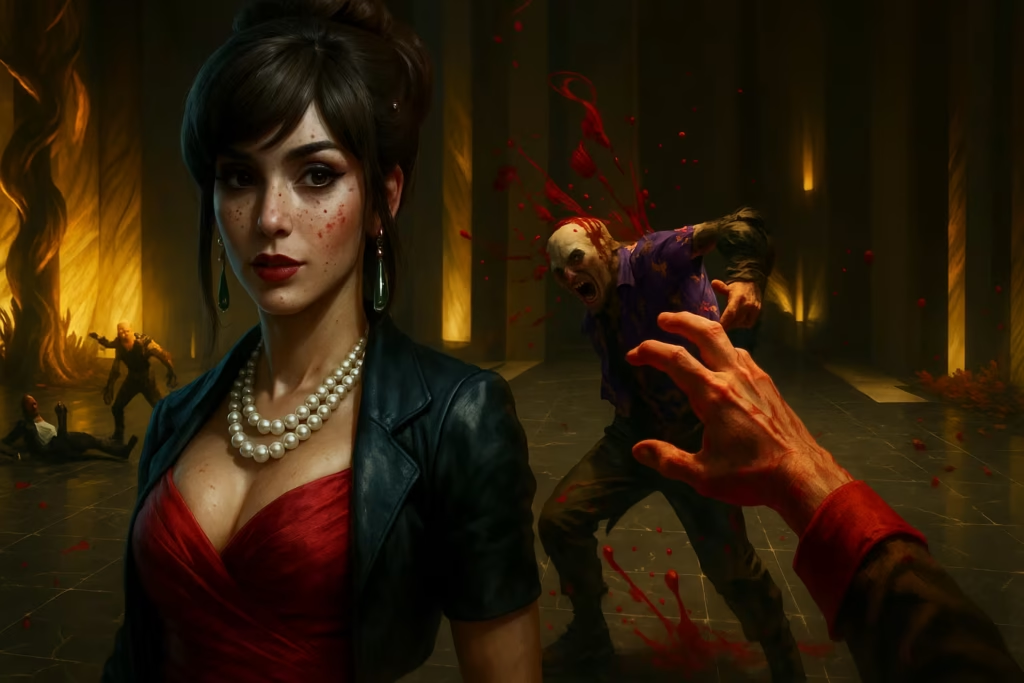Vampire: The Masquerade – Bloodlines 2 is a dark, atmospheric RPG that thrives on immersion — but performance issues like lag, stuttering, or FPS drops can easily break that mood. Whether you’re stalking the streets of Seattle or engaging in intense combat, keeping your frame rate stable makes all the difference. This guide covers the best graphics settings to help you balance visuals and smooth gameplay.

Why Bloodlines 2 Struggles on PC
Despite its reasonable system requirements, Bloodlines 2 currently faces optimization issues across hardware tiers. Even players using RTX 4000–5000 GPUs report inconsistent frame pacing, input delay, and stuttering, especially at higher resolutions.
These problems often stem from:
Pokémon Legends: Z-A – Nintendo Switch 2
- Unoptimized rendering pipelines.
- Poor frame generation scaling (DLSS 4, FSR).
- Excessive post-processing and shadow effects.
- Background system processes eating into GPU or CPU bandwidth.
The good news? With a few adjustments, you can dramatically improve your performance and keep the game running smoothly.
Minimum and Recommended Specs
| Setting | Minimum (1080p, 30 FPS) | Recommended (1080p, 60 FPS) |
|---|---|---|
| OS | Windows 10 64-bit | Windows 11 64-bit |
| CPU | Intel i3-8350K / AMD Ryzen 3 3300X | Intel i5-12600K / AMD Ryzen 5 5600X |
| GPU | GTX 1060 6 GB / RX 480 / Arc A580 | RTX 3060 Ti / RX 6700 XT |
| VRAM | 6–8 GB | 8–12 GB |
| RAM | 8 GB | 16 GB |
| Storage | 30 GB HDD/SSD | 30 GB SSD recommended |
Even if your PC matches the recommended tier, you might still need to tweak settings to achieve stable 60 FPS gameplay.
Best Graphics Settings for Maximum Performance
After testing across various GPUs (RTX 3060, RTX 4070, and RTX 5070), these settings give the best mix of clarity and performance:
| Setting | Recommended Value | Impact |
|---|---|---|
| VSync | Off (unless screen tearing) | Disabling removes input lag. |
| Frame Rate Limit | Unlimited (or 60 FPS cap) | Keeps GPU load consistent. |
| Nvidia Reflex Low Latency | Enabled + Boost | Improves input response. |
| DLSS / FSR | Quality (Balanced for 1440p) | Use DLSS 4 or FSR 3 for smoother frames. |
| DLSS Frame Generation | 2× (RTX 4000) / 4× (RTX 5000) | Helps boost FPS, but may add latency. |
| Global Illumination | High | Maintains lighting depth without big FPS loss. |
| Shadows | Medium | High cost on GPU; reduce if stuttering. |
| Anti-Aliasing | TAA Medium | Smooths edges without blurring. |
| View Distance | Far | Slightly impacts CPU, leave as is. |
| Texture Quality | High | VRAM heavy; drop to Medium if below 8 GB VRAM. |
| Effects | Medium | Reduces GPU strain during combat. |
| Reflections | Medium | Turn down to boost FPS in dense areas. |
| Post-Processing | Medium | Keeps cinematic tone but saves ~10 FPS. |
| Motion Blur / Film Grain | Off | Removes visual noise and input lag. |
| Volumetric Fog | Medium | Reduces GPU load in fog-heavy zones. |
These settings maintain an average of 58–65 FPS at 1080p, 50–55 FPS at 1440p, and around 40 FPS at 4K depending on GPU power.
Additional Optimization Tips for Smoother Gameplay
1. Update Drivers and Game Patches
Install the latest Nvidia or AMD drivers. These often include shader and API optimizations specifically for new titles. Also, make sure your game is patched to the latest version—many launch-day bugs have been addressed in recent updates.
2. Use High Performance Mode
In Windows, go to Power Options > High Performance to ensure the CPU runs at full speed instead of throttling.
3. Close Background Tasks
Disable overlays (Steam, Discord, GeForce Experience) and close Chrome tabs or other heavy applications before launching the game.
4. Set Game Priority to High
Open Task Manager → Details tab, right-click the game process, and set its priority to High. This gives Bloodlines 2 more CPU resources.
5. Clean GPU Cache
Clearing shader and DirectX caches can fix random stutters caused by outdated compiled data. Use your GPU control panel or manually delete the cache folder.
Advanced Options for Enthusiasts
If you’re on RTX 5000 series or equivalent hardware:
- Enable DLSS 4 Frame Gen but disable VSync to avoid latency loops.
- Use CapFrameX or Nvidia FrameView to monitor frame pacing in real time.
- Adjust Dynamic Resolution Scaling (DRS) for smoother output when heavy post-processing effects are enabled.
For AMD GPU owners, FSR 3 can be toggled in the FidelityFX menu to improve performance without significant visual loss.
Troubleshooting FPS Drops in Vampire The Masquerade Bloodlines 2
Even with optimal settings, you might notice frame dips or input lag during cutscenes or open-world transitions. Try these quick fixes:
- Run the game from an SSD to reduce loading-related stutter.
- Verify the game files via Steam → Properties → Installed Files → Verify Integrity.
- Temporarily disable multi-frame generation if frame times fluctuate wildly.
- Keep temperature monitoring tools like MSI Afterburner open—throttling can mimic lag.
Vampire: The Masquerade – Bloodlines 2 still needs patches to unlock its full PC potential, but with the above configuration, you can achieve stable performance without sacrificing the game’s moody atmosphere.
See also: Best Ninja Gaiden 4 Graphics Settings for Maximum FPS
Tweak, test, and monitor your performance—the difference between a choppy 40 FPS and a buttery-smooth 60 FPS could come down to just one setting. Play Now!
More Gaming Guides
- 01FC 26 Frostbite Finisher Evolution Best Players – Top Strikers to Upgrade
- 02Where to Find Advanced Electrical Components in ARC Raiders
- 03All Wishblossom Ranch Recipes in Disney Dreamlight Valley
- 04How to Find Tomo’s Lost Cat in The Forge – Complete Quest Walkthrough
- 05Diablo 4 Goblin Event Rewards and Loot Guide
- 0610 Best Minecraft Pocket Edition Seeds to Try Right Now
- 07Arknights Endfield Release Date, Platforms, Gameplay, and What to Expect


